|
|

|
|
Author
|
Topic: NASA's Artemis III (Orion/Starship HLS)
|
Robert Pearlman
Editor Posts: 53407
From: Houston, TX
Registered: Nov 1999
|
 posted 03-11-2021 03:30 PM
posted 03-11-2021 03:30 PM
   
NASA release Artemis III: NASA's First Human Mission to the Lunar South PoleHumans have always been drawn to explore, discover, and learn as much as we can about the world—and worlds—around us. This isn't always easy, but it's in our nature. For the benefit of all humanity, NASA and its partners will land the first woman and first person of color on the surface of the Moon with Artemis. Following two Artemis test missions, Artemis III, currently planned for 2025, will mark humanity's first return to the lunar surface in more than 50 years. NASA will make history by sending the first humans to explore the region near the lunar South Pole. 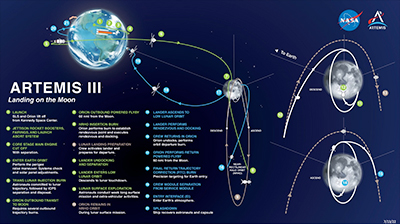 On the way NASA's Orion spacecraft will be the crew's ride to and from Earth and into and out of lunar orbit. Orion is the only spacecraft capable of returning crews to Earth at lunar reentry velocities. On the successful Artemis I mission, Orion's uniquely designed heat shield was recently tested under these extreme reentry conditions. Four astronauts will depart from Launch Pad 39B at Kennedy Space Center in Florida atop the Space Launch System (SLS), the only rocket powerful enough to send Orion, its crew, and their supplies to the Moon in a single launch. The crew will be selected from among the most diverse astronaut corps in history, each equipped with unique skills and intensively trained. First the crew will launch to Earth orbit where they will perform systems checks and solar panel adjustments on Orion. Then, a powerful push from SLS's interim cryogenic propulsion stage will help Orion perform a translunar injection maneuver, setting its course to the Moon. For several days, the crew will travel toward the Moon and perform corrective engine burns to intercept the Moon's gravitational field. At the right time and location, Orion will perform a series of two engine burns to place the spacecraft in a lunar Near-Rectilinear Halo Orbit (NRHO). From hundreds of potential orbits, NASA selected NRHO to achieve long-term Artemis goals. NRHO will provide near-constant communications with Earth and access to sites all over the Moon. Because it is gravitationally balanced between Earth and the Moon, this orbit will maximize fuel efficiency. On future missions, NASA and its partners will assemble the Gateway lunar space station in NRHO to serve as a hub for Artemis missions. NASA has selected SpaceX to provide the human landing system that will transport Artemis III astronauts from Orion in lunar orbit to the surface of the Moon and back again. SpaceX plans to use a unique concept of operations to increase the overall efficiency of their lander. After a series of tests, SpaceX will fly at least one uncrewed demo mission that lands Starship on the lunar surface. When Starship has met all of NASA's requirements and high standards for crew safety, it will be ready for its first Artemis mission. Before the crew launch, SpaceX will launch a storage depot to Earth orbit. A series of reusable tankers will carry propellant to the storage depot to fuel the human landing system. The uncrewed Starship human landing system will then launch to Earth orbit and rendezvous with the storage depot to fill its tanks before executing a translunar injection engine burn and traveling approximately six days to NRHO where it will await the Artemis III crew. When both spacecraft have arrived in NRHO, Orion will dock with the Starship human landing system in preparation for the first lunar surface expedition of the 21st century. Once the crew and their supplies are ready, two astronauts will board Starship and two will remain in Orion. Orion will undock and back away from Starship to remain in NRHO for roughly one orbit around the Moon, lasting about 6.5 days. This will match the length of the surface expedition, so as Orion completes its orbit, the two person surface crew will finish their work on the surface in time to launch back up to meet the spacecraft. NASA has its sights set on locations around the South Pole for the Artemis era of human lunar exploration. Extreme, contrasting conditions make it a challenging location for Earthlings to land, live, and work, but the region's unique characteristics hold promise for unprecedented deep space scientific discoveries. Using advanced technology including autonomous systems, the crew inside of Starship will land at a carefully selected site within a 100-meter radius. On the Moon After touchdown, the surface crew's first task will be to ensure all systems are ready for their lunar surface stay. Then they will rest, eat, and recharge for the first full day of the expedition. During their time on the Moon, the astronauts will do scientific work inside Starship and conduct a series of moonwalks, exiting Starship to explore the surface. The astronauts will don advanced spacesuits, exit through an airlock, and descend on Starship's elevator. NASA has selected Axiom Space to provide the Artemis III surface suits and spacewalk systems. These suits will give the astronauts increased range of motion and flexibility to explore more of the landscape than on previous lunar missions. During their moonwalks, the astronauts will take pictures and video, survey geology, retrieve samples, and collect other data to meet specific scientific objectives. The view from the lunar South Pole region will look very different from the photos taken on Apollo missions in the Moon's equatorial region. The Sun will hover just above the horizon, casting long, dark shadows across the terrain, which the crew will explore using headlamps and navigational tools. The information and materials collected by Artemis III astronauts will increase our understanding of the mysterious South Pole region, the Moon, and our solar system. Mission control teams on the ground will be in contact with the crew as they relay what they see, hear, and feel. Through mission coverage and the ability to send high quality images and video to the ground with advanced communication technology, they will be sharing a unique new human experience with the world. On the journey home When their surface expedition is complete, the two astronauts will lift off the surface of the Moon and head back to NRHO in Starship to reunite with their crewmates in Orion. After docking, the crew will spend up to five days in orbit, transferring samples between the vehicles and preparing for the journey back to Earth. When they reach the optimal NRHO departure point, with all four astronauts back in Orion, they will undock and ignite Orion's engines, slinging the spacecraft past the Moon, and allowing it to coast toward Earth. The crew will travel about 24,855 miles (about 40,000 kilometers) per hour during reentry into Earth's atmosphere. Assisted by 11 parachutes, the spacecraft will splash down in the Pacific Ocean where it and the crew will be retrieved with support from the U.S. Coast Guard and U.S. Navy. Artemis III will be one of the most complex undertakings of engineering and human ingenuity in the history of deep space exploration to date. The astronauts' observations, samples, and data collected will expand our understanding of our solar system and home planet, while inspiring the next generation. This mission will usher in a future in which humans consistently access the Moon, and human planetary exploration missions are within reach. Each Artemis mission will increase our knowledge, refine our operations, and prove our technology as we prepare for the first human mission to Mars. |
Robert Pearlman
Editor Posts: 53407
From: Houston, TX
Registered: Nov 1999
|
 posted 03-11-2021 03:38 PM
posted 03-11-2021 03:38 PM
   
NASA photo release (credit: NASA/Michael DeMocker) At NASA’s Michoud Assembly Facility in New Orleans, technicians from Orion prime contractor Lockheed Martin have welded together three cone-shaped panels on Orion’s crew module for the Artemis III mission that will land the first woman and next man on the moon. The crew module’s primary structure, the pressure vessel, is comprised of seven machined aluminum alloy pieces that are welded together through a weld process that produces a strong, air-tight habitable space for astronauts during the mission. Once welding of the Artemis III crew module primary structure is complete, it will be shipped to NASA’s Kennedy Space Center in Florida where it will undergo further assembly beginning this fall. 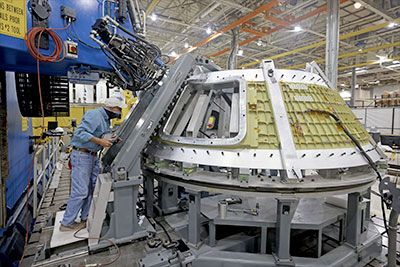 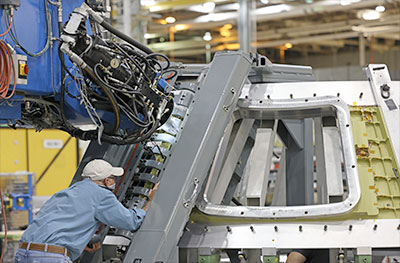
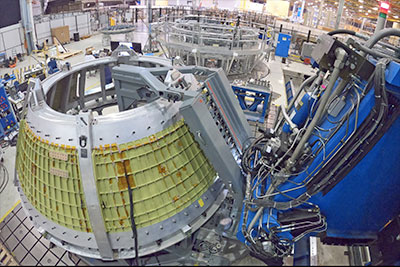
|
Robert Pearlman
Editor Posts: 53407
From: Houston, TX
Registered: Nov 1999
|
 posted 12-06-2022 01:50 PM
posted 12-06-2022 01:50 PM
   
NASA release NASA advances moon rocket production for Artemis III, future missionsNASA is moving forward with Space Launch System (SLS) production and assembly activities for future Artemis missions. 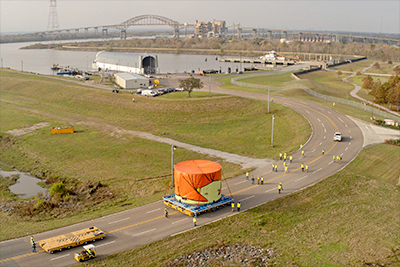 Above: Teams at NASA’s Michoud Assembly Facility in New Orleans move the engine section flight hardware to the agency’s Pegasus barge Sunday, Dec. 4. The barge will ferry the engine section of NASA’s Space Launch System (SLS) rocket for Artemis III to the agency’s Kennedy Space Center in Florida. Teams at Kennedy will finish outfitting the engine section, which comprises the tail-end of the 212-foot-tall core stage, before integrating it with the rest of the stage. (NASA/Michael DeMocker) The agency is optimizing manufacturing capabilities by enabling SLS core stage lead contractor Boeing to use facilities at NASA's Kennedy Space Center in Florida to perform some core stage assembly and outfitting activities beginning with the Artemis III rocket. In tandem, teams will continue all core stage manufacturing activities at NASA's Michoud Assembly Facility in New Orleans. As the SLS program transitions from rocket development efforts to operations, NASA and Boeing evaluated how to improve upon the time required to produce each core stage and best use space at Michoud. "We're making progress developing, manufacturing, and assembling elements for future Artemis missions," said Jim Free, associate administrator for the Exploration Systems Development Mission Directorate. "Our collective workforce across NASA centers and industry partners plays a key role in accomplishing NASA's long-term plans for exploring the Moon." Beginning with production for Artemis III, NASA and Boeing will use Michoud, where the SLS core stages are currently manufactured, to produce and outfit the core stage elements, and available space at Kennedy for final assembly and integration. This opportunity provides for multiple mission elements to be manufactured and outfitted at the same time and for the workforce at Michoud to begin building the rocket's exploration upper stage, which will enable SLS to send even heavier and larger cargo to the Moon on the same missions with astronauts beginning with Artemis IV. All five major core stage structures will be manufactured at Michoud using current robotic welding tools and fixtures and complete all thermal protection system spray applications at Michoud. There, the forward skirt, the intertank, liquid oxygen tank, and the liquid hydrogen will continue to be outfitted and joined to form the upper part of the core stage. Upon completion, these structures, which comprise the top four-fifths of the 212-foot-tall stage, will be shipped to Kennedy's Vehicle Assembly Building (VAB) where they will be joined and vertically integrated in High Bay 2. Once the engine section structure is manufactured, it will be transported to Kennedy's Space Station Processing Facility for outfitting in the facility. When the engine section is completely outfitted, it and the stage's four RS-25 engines will be moved to the VAB's High Bay 2 for integration with the rest of the core stage, where technicians can more easily move it for stacking and assembly operations. Four of five major core stage parts for Artemis II have been joined, and teams are outfitting the last part, the engine section, and will soon connect it and the RS-25 engines to complete the stage at Michoud. The Artemis II stage is scheduled to be completed and delivered to Kennedy in 2023. The engine section for the Artemis III SLS core stage is expected to arrive at Kennedy in mid-December. |
Robert Pearlman
Editor Posts: 53407
From: Houston, TX
Registered: Nov 1999
|
 posted 01-18-2023 11:06 AM
posted 01-18-2023 11:06 AM
   
NASA photo updates April 18, 2022 - The core stage liquid hydrogen tank for the Artemis III mission completed proof testing, and technicians returned it to the main factory building at NASA's Michoud Assembly Facility in New Orleans where it will undergo more outfitting. 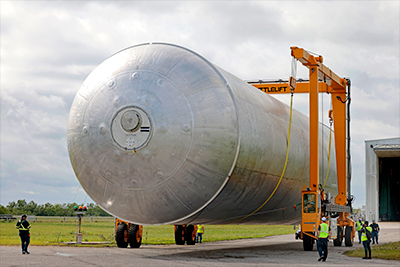 July 27, 2022 — Teams completed the welding of the Artemis III core stage liquid oxygen tank dome at the NASA's Michoud Assembly Facility in New Orleans. 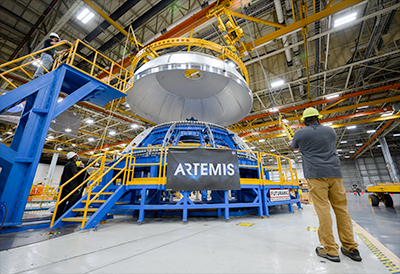 October 26, 2022 — Technicians at NASA's Michoud Assembly Facility move the intertank of NASA's Space Launch System rocket for Artemis III to Cell G to await application of the thermal protection system. 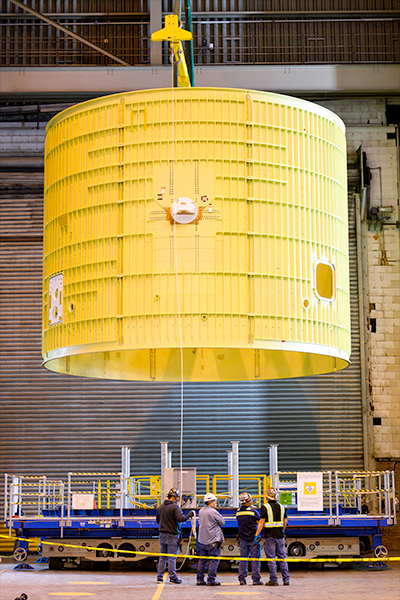 December 15, 2022 — The engine section of the Space Launch System rocket's core stage for NASA's Artemis III mission is moved on a work stand into the high bay of the Space Station Processing Facility (SSPF) at NASA's Kennedy Space Center in Florida. 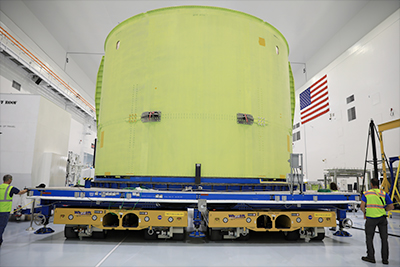 |
Robert Pearlman
Editor Posts: 53407
From: Houston, TX
Registered: Nov 1999
|
 posted 05-04-2023 02:26 PM
posted 05-04-2023 02:26 PM
   
Aerojet Rocketdyne release Aerojet Rocketdyne Delivers Propulsion for Artemis III MissionAerojet Rocketdyne recently completed the four RS-25 engines that will power the core stage of NASA's super heavy-lift Space Launch System (SLS) rocket during the historic Artemis III mission. Slated for launch around the middle of the decade, Artemis III is a planned lunar landing mission that will return humans to the surface of the Moon for the first time in more than 50 years. 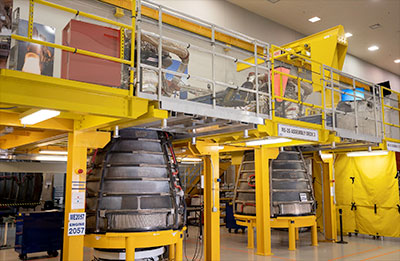 "The Artemis III mission is pivotal in our nation's goal to return American astronauts to the surface of the Moon, establish a sustained presence there and pave the way for crewed missions to Mars," said Eileen P. Drake, Aerojet Rocketdyne CEO and president. "As our nation makes this next giant leap in its space program, it is leveraging the extensive knowledge and lessons learned that were gained during our earlier exploration efforts, including the Apollo, Space Shuttle and Artemis I missions. We are truly standing on the shoulders of those who pioneered the exploration of deep space." The four RS-25 engines that will power the SLS rocket's core stage during the Artemis III mission have been upgraded following their service during the shuttle program and will now generate about 2 million pounds of combined thrust. The Artemis III RS-25 engines safely flew 138 individual astronauts to orbit and supported 26 Space Shuttle missions, including: - Multiple International Space Station assembly missions
- STS-95: The flight of then-U.S. Senator John Glenn, one of NASA's original Mercury astronauts
- STS-114: The Space Shuttle program's return to flight following the Columbia accident
- STS-125: The final Hubble servicing mission
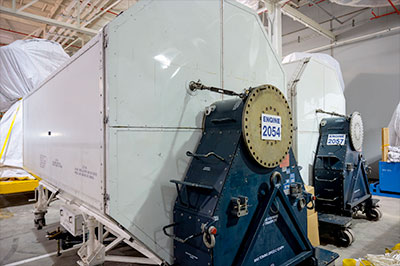 In addition to the RS-25 engines, Aerojet Rocketdyne has delivered all of its other propulsion systems for the Artemis III SLS rocket and a majority of the propulsion systems for the Orion spacecraft. Additional Aerojet Rocketdyne propulsion on the Artemis III mission includes the RL10 engine and 12 MR-106 reaction control system thrusters that will support the SLS's second stage, called the Interim Cryogenic Propulsion Stage. Aerojet Rocketdyne also supplies major propulsion elements for NASA's Orion spacecraft, including the Orion Main Engine; the jettison motor on the Launch Abort System; eight auxiliary engines for trajectory control and positioning on the service module; and 12 reaction control system engines that guide the Orion crew module's atmospheric re-entry. Aerojet Rocketdyne's Artemis III propulsion contributions are designed, built and tested at various sites across the country, including Los Angeles, California; NASA's Stennis Space Center in Mississippi; West Palm Beach, Florida; Redmond, Washington; Huntsville, Alabama; and Orange, Virginia. The pressurized tanks used for Orion's life support systems and flotation system for recovery at sea were manufactured and delivered by Aerojet Rocketdyne's ARDÉ subsidiary, located in Carlstadt, New Jersey. |
Robert Pearlman
Editor Posts: 53407
From: Houston, TX
Registered: Nov 1999
|
 posted 08-17-2023 11:36 AM
posted 08-17-2023 11:36 AM
   
United Launch Alliance (ULA) photo release Check out ULA photos from the arrival of ICPS-3 [Interim Cryogenic Propulsion Stage-3], the upper stage that will propel Artemis III astronauts to the moon! 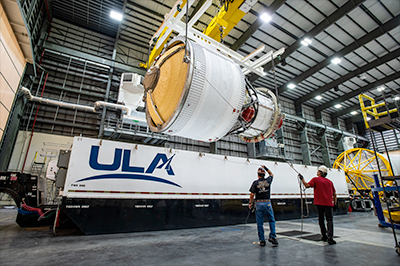 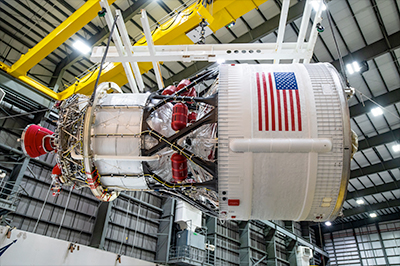
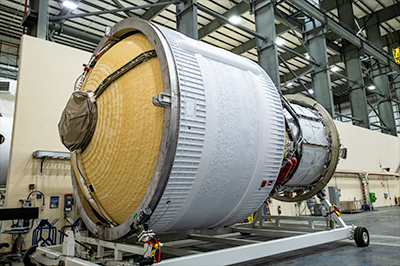
|
Robert Pearlman
Editor Posts: 53407
From: Houston, TX
Registered: Nov 1999
|
 posted 01-05-2024 05:50 PM
posted 01-05-2024 05:50 PM
   
NASA photo release Teams move the core stage liquid hydrogen tank for the Artemis III mission to a priming cell near the Vertical Assembly Building at NASA’s Michoud Assembly Facility in New Orleans Nov. 21, 2023. Technichians will sand down and prepare the suface of the tank before coating it in a primer. Primer is applied to the barrel section of the tank by an automated robotic tool, whereas the forward and aft domes are primed manually. Once priming is complete, technicians with NASA and Boeing, the SLS core stage prime contractor, will apply a foam-based thermal protection system, which protects the propellant tank from the extreme temperatures it will face during launch and flight while also regulating the super-chilled propellant within it. 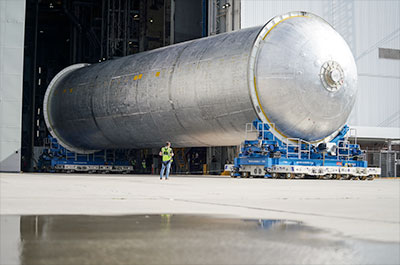 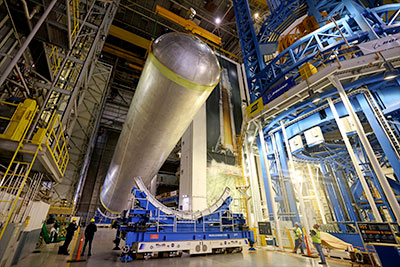
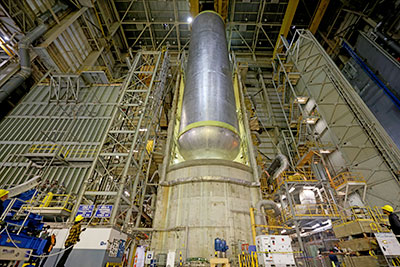
|
Robert Pearlman
Editor Posts: 53407
From: Houston, TX
Registered: Nov 1999
|
 posted 01-09-2024 07:02 PM
posted 01-09-2024 07:02 PM
   
collectSPACE NASA delays Artemis II and III astronaut moon missions to 2025, '26NASA has delayed the return of astronauts to the moon to address engineering issues and provide more time for the development of new vehicles and equipment. ... NASA also pushed back Artemis III, its first mission to land astronauts on the moon since the Apollo program did so more than 50 years ago, from late 2025 to September 2026. The delay acknowledges development challenges that have been experienced by NASA's commercial partners, including SpaceX for the human landing system and Axiom Space for next-generation lunar spacesuits. 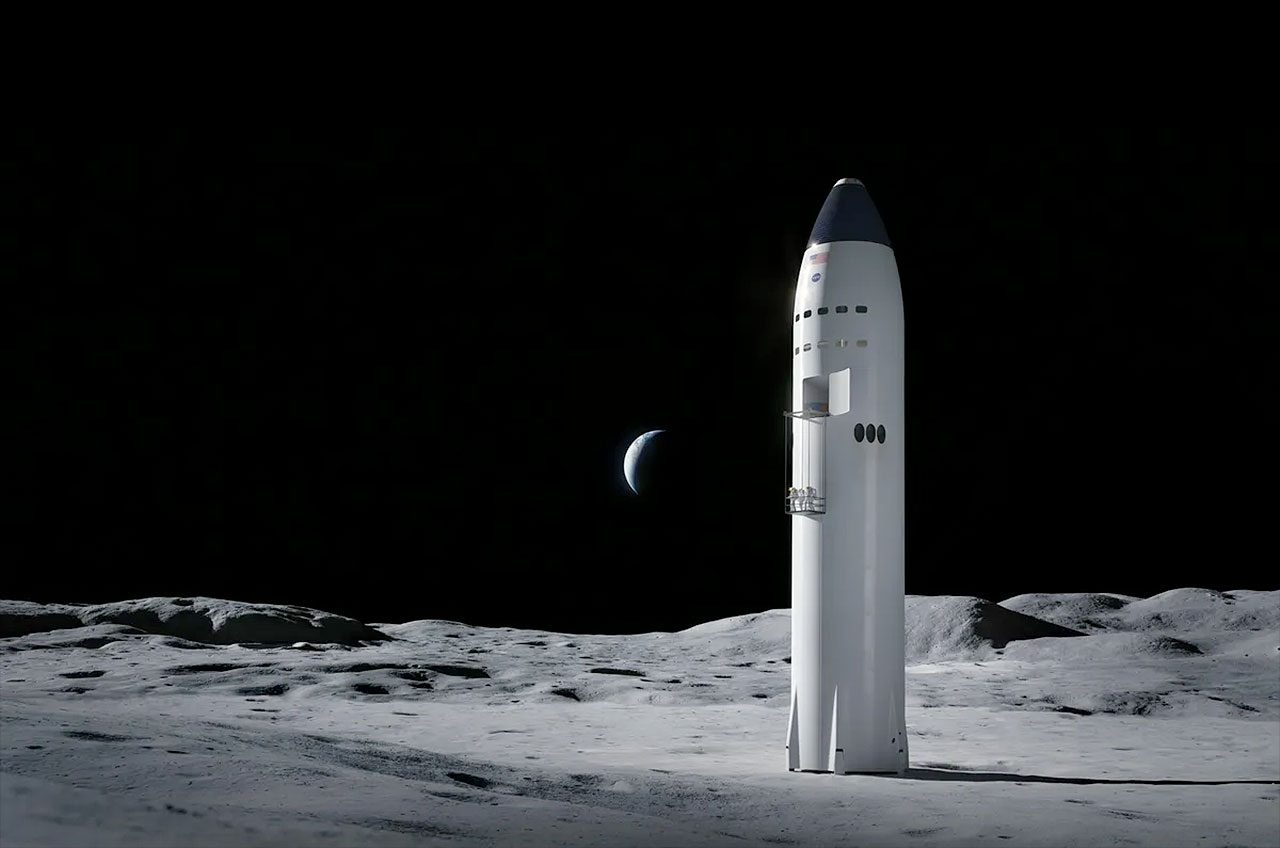 |
Robert Pearlman
Editor Posts: 53407
From: Houston, TX
Registered: Nov 1999
|
 posted 09-03-2024 06:59 PM
posted 09-03-2024 06:59 PM
   
NASA photo release The transport carrier containing the European Service Module for NASA's Artemis III mission arrives at the Neil A. Armstrong Operations and Checkout Building at NASA's Kennedy Space Center in Florida on Tuesday, Sept. 3, 2024. 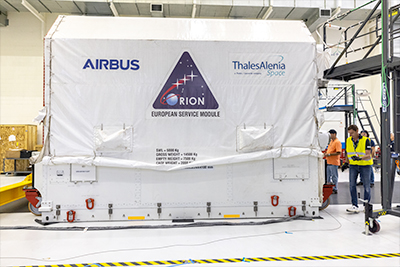 | |
Contact Us | The Source for Space History & Artifacts
Copyright 1999-2024 collectSPACE. All rights reserved.

Ultimate Bulletin Board 5.47a
|
|

|
 advertisement advertisement

|






























